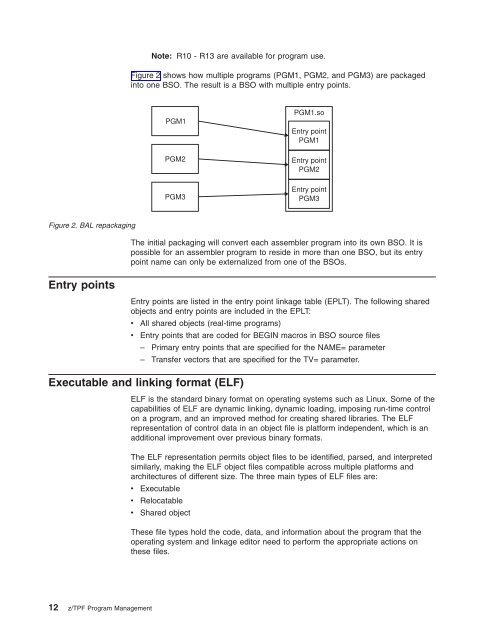z/TPF Program Management - IBM
z/TPF Program Management - IBM
z/TPF Program Management - IBM
You also want an ePaper? Increase the reach of your titles
YUMPU automatically turns print PDFs into web optimized ePapers that Google loves.
Figure 2. BAL repackaging<br />
Entry points<br />
Note: R10 - R13 are available for program use.<br />
Figure 2 shows how multiple programs (PGM1, PGM2, and PGM3) are packaged<br />
into one BSO. The result is a BSO with multiple entry points.<br />
The initial packaging will convert each assembler program into its own BSO. It is<br />
possible for an assembler program to reside in more than one BSO, but its entry<br />
point name can only be externalized from one of the BSOs.<br />
Entry points are listed in the entry point linkage table (EPLT). The following shared<br />
objects and entry points are included in the EPLT:<br />
v All shared objects (real-time programs)<br />
v Entry points that are coded for BEGIN macros in BSO source files<br />
– Primary entry points that are specified for the NAME= parameter<br />
– Transfer vectors that are specified for the TV= parameter.<br />
Executable and linking format (ELF)<br />
12 z/<strong>TPF</strong> <strong>Program</strong> <strong>Management</strong><br />
PGM1<br />
PGM2<br />
PGM3<br />
PGM1.so<br />
Entry point<br />
PGM1<br />
Entry point<br />
PGM2<br />
Entry point<br />
PGM3<br />
ELF is the standard binary format on operating systems such as Linux. Some of the<br />
capabilities of ELF are dynamic linking, dynamic loading, imposing run-time control<br />
on a program, and an improved method for creating shared libraries. The ELF<br />
representation of control data in an object file is platform independent, which is an<br />
additional improvement over previous binary formats.<br />
The ELF representation permits object files to be identified, parsed, and interpreted<br />
similarly, making the ELF object files compatible across multiple platforms and<br />
architectures of different size. The three main types of ELF files are:<br />
v Executable<br />
v Relocatable<br />
v Shared object<br />
These file types hold the code, data, and information about the program that the<br />
operating system and linkage editor need to perform the appropriate actions on<br />
these files.

















